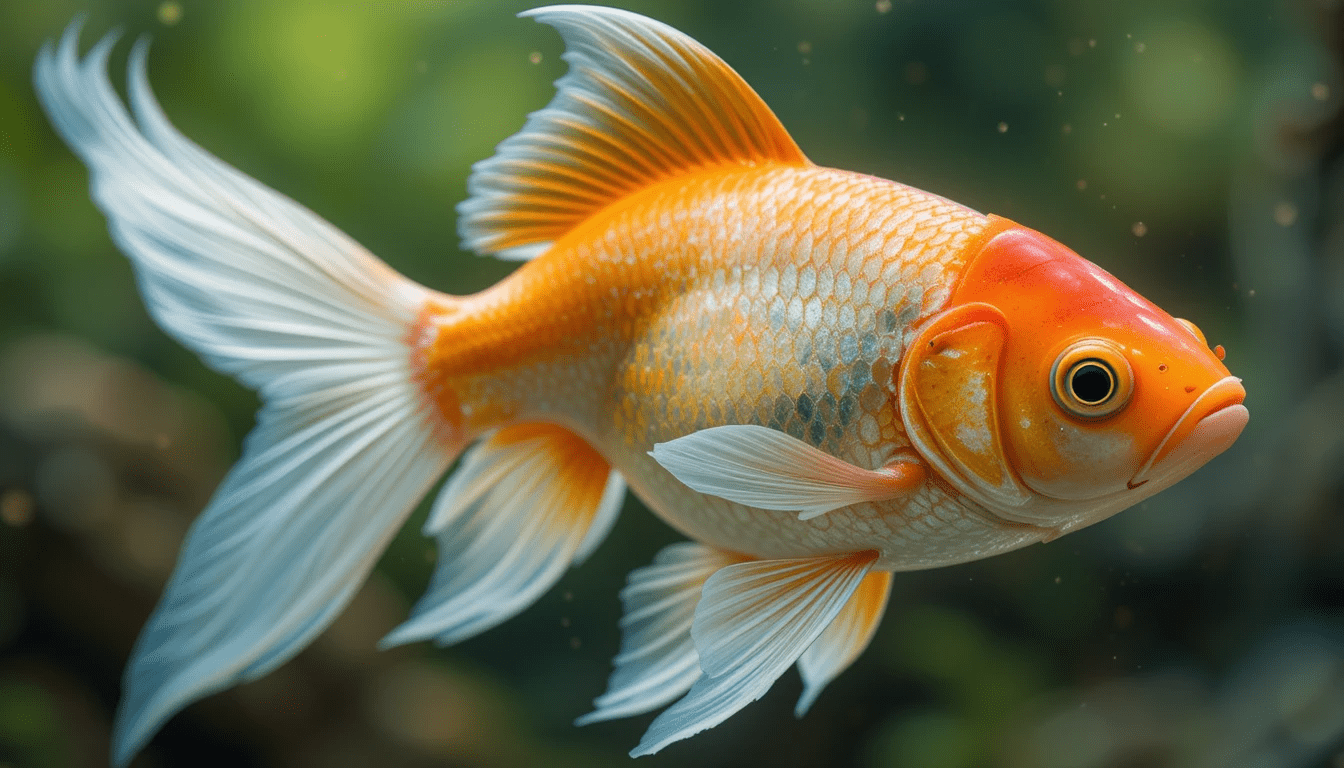When you notice goldfish turning white, it’s important to understand that these fish have unique genetics that can cause color changes over time. Goldfish, being a species that was conceived through thousands of years of selective breeding, carry dormant genes, including those for color, which can affect how the fish looks.
Symmetrical color changes are often a sign of this natural process, especially when the goldfish is gradually turning white with a well-distributed symmetrical pattern. In most cases, this is completely normal and nothing to worry about, as it’s simply due to the fish’s genetics. However, there are times when goldfish turning white could be a warning sign. The species, though resilient, is sensitive to environmental changes and disturbances, which can induce stress. This stress can lead to serious issues like fungal infections, a common cause of goldfish turning white.

Other factors, such as poor water parameters, can also contribute to these color changes. When your fish begins turning from bright gold to white, it can cause concern, but most of the time, the causes are benign and not severe. It’s essential to read and know what to look for, especially when changes happen suddenly, so you can take the right steps to care for your pet.
Is It Normal for a Goldfish to Turn White?
If your goldfish turns white, it is important to pay attention to how the color change is happening. If the white is symmetrically distributed across the body, it’s generally not a bad sign. However, if you notice irregular white patches, spots, or color changes that seem uneven, it may point to an underlying health or environmental issue.
Goldfish have a long and beautiful history, originating in China around the 9th century. Tied to Buddhist traditions, goldfish were seen as a means of self-purification. Over time, goldfish were domesticated and selectively bred, particularly for their color, which led to the development of the golden hue many people recognize today, often appearing yellow-orange. This selective breeding led to a natural genetic mutation that gave rise to the beloved golden goldfish. Over time, other colored goldfish, like the silver variety, became rarer due to the dominance of these recessive genes.
As goldfish mature, it is natural and common to see them turn color. This natural change is usually distributed in noticeable patterns, often starting at the extremities of the fins and tail.
Understanding Why Goldfish Turn White and How to Help
Now that you’re familiar with the reasons why goldfish can alter their color, let’s examine why your specific fish is showing this symptom
Illness, Parasites, & Infections
This is the most dreaded cause of concern. After becoming a skilled hobbyist, the unfortunate reality of fish ownership may arise when you see your goldfish in pain.
The goldfish turning white isn’t specific to one disease but rather a symptom of various illnesses, which can only be diagnosed by considering other accompanying signs.
If your goldfish is losing color while also showing symptoms like a lack of appetite, sluggish behavior, and weight loss, it could be an indication of an infection. Common culprits include fungal, bacterial, and parasitic infections.
Diseases such as ich (white spot disease) and Malawi bloat are typically associated with goldfish turning white.
It’s important to closely monitor the changes in the white coloration. Serious illnesses, like dropsy, can cause dangerous white lesions. In such cases, it’s best to consult a skilled professional for medical advice on the next steps for treatment.
As a precaution, always quarantine sick fish. Infections spread rapidly in aquariums, and isolating the ill fish helps protect the rest of your aquatic community.
Impure Water
One of the most common issues with goldfish turning white is poor water quality. You see, maintaining optimal conditions in your tank is vital for the health of your fish. If the pH levels, ammonia, nitrites, and nitrates are not at the recommended levels, it can lead to discoloration or even stress for your goldfish.
The water in most houses is filled with chlorine because it comes from the main distribution system, which can further affect your fish’s health. I always recommend using a test kit to ensure everything is up to par, so you can avoid any surprises. Additionally, overfeeding your goldfish may contaminate the water, which puts unnecessary stress on them in the long run, even though they have a friendly and easygoing nature. It’s tempting to pamper them with extra food, but remember that the fish problems that arise from this can be difficult to fix. If you don’t keep a close eye on these factors, you could be facing headaches down the line.
Water Conditions
When your goldfish starts turning white, it’s important to look beyond just the water quality. Temperature and oxygen levels in the tank play a huge role in maintaining the right environment.
For goldfish, the recommended water temperature is between 50-60 degrees Fahrenheit. Colder temperatures can enhance their colors, while hotter temperatures can make them appear less intensely colored. Low oxygen levels are fatal to goldfish, as they need around 5-6 PPM of dissolved water to thrive in their aquarium. If you’ve been testing the water weekly, you’ll know if oxygen is the issue. If the goldfish is struggling to breathe and appears lethargic, this could be a sign. The fastest fix is to perform a 60% water change, and always monitor these parameters. If there’s no improvement, then it’s time to explore other causes.
Light Exposure
When it comes to goldfish turning white, one possible cause is insufficient ultraviolet light exposure. Goldfish rely on UV light intensities to help their pigments shift and maintain their vibrant colors.
These fish have two types of pigment cells: melanocyte pigments for dark pigmentation and chromatophores for coloration. When they don’t get enough UV light, these cells produce paler or whitish colors. However, this isn’t always the main cause since goldfish also receive coloration nutrients from their food, allowing them to maintain their vibrant goldish color even without much light. In fact, goldfish thrive in an environment that provides about 12 hours of sunlight or artificial lighting with ultraviolet light, which is beneficial not only for their health and vibrancy, but also for keeping their low-stress levels intact.
Improper Diet
One key factor behind goldfish turning white is an improper diet. A healthy fish diet includes vitamin meals and foods that are rich in pigmentation nutrients like carotenoids, which help maintain the goldfish’s color. Foods like shrimp, krill, spinach, carrot, and spirulina algae are great examples of what you can feed your fish.
A poor diet deprives the fish of these essential carotenoids, which can cause the goldfish to lose its vibrant color, especially when combined with factors like low UV light. If this happens, you can turn to packaged fish foods that contain canthaxanthin, an artificially added pigment that enhances the color of your fish and can help reverse discoloration caused by an improper diet.
Genetics
Goldfish are a man-made species with many recessive colors hidden in their DNA, making their color change unpredictable over their life. The parent stock plays a big role, as color qualities in the parents are generally stable, but still not always predictable.
For example, one goldfish might turn from orange to white, while another in the same tank could go from orange to black. The dominant colors from the parent stock are usually more stable, so it’s worth talking to an expert about the color life cycle to know what colors you can expect. Sometimes, recessive colors appear during the goldfish’s lifespan, and this can cause the fish to start turning white, especially when the natural colors fade towards the lower ends of the fins, particularly the dorsal fins. Sadly, this is a natural process we have no control over.
The Aging Process
As your goldfish matures, it will naturally undergo color changes. In the earlier years, you may notice a shift from bronze to orange, and later, it might turn from orange to white as it grows older. Some maturing goldfish can even change from white to orange, black to orange, or orange to black.
Typically, the color change slows down after the first few years, often by around two years, but for some goldfish, the process can continue for more than ten years. Since goldfish can live up to 15 years, it’s interesting to watch how they evolve over time. This change happens due to the chromatophores, special cells that are responsible for color. Each fish has a certain number of chromatophores, which mostly remain fixed throughout its life. As the fish grows, these cells cover wider areas of the skin and stretch, making the color appear paler. This is why your goldfish turns white as it gets older
Can Goldfish Return To Their Original Color?
In most cases, yes, goldfish can return to their original color. Goldfish keeping can be a challenging hobby, but by closely monitoring their health and conditions, you can often identify issues before they become too serious. Providing clean water quality, a healthy diet, and sometimes medications can help your goldfish regain its beautiful coloration. The time it takes for the color to return can vary, from as little as a day to several weeks, depending on the severity of the issue.
FAQs
What to Do If Your Goldfish Turns White?
If your goldfish starts turning white, the best thing you can do is provide quality foods and perform frequent water changes. If the condition worsens, consider placing the fish in a hospital tank and treating it with broad-spectrum or antibiotic treatments.
Can Goldfish Regain Their Color?
Yes, goldfish can regain their color over time. The process depends on various factors, including genetics and the health of the fish. Typically, it can take a few weeks for a goldfish to start showing improvement in color if the proper care, such as a healthy diet and clean water, is provided. However, the original color may not always return, especially if the fish is aging. For example, I once had a black moor that gradually turned completely orange. While its original color didn’t come back, it might change again as it continues to mature.
Why Did My Fish Go White?
There are several reasons why your fish might have turned white. Genetics plays a significant role, as some fish naturally change color as they age. In many cases, fish will cycle through different colors, including black, orange, silver, and white, depending on their age and other factors. These factors can include light, the food they eat, and water levels such as ammonia, nitrites, nitrates, and changes in tank pH. These environmental conditions, along with the fish’s natural life cycle, can influence its color.
Conclusion
The color of a goldfish is one of its most attractive qualities, drawing people into the fishkeeping hobby. While coloration is a factor to consider when getting any fish, it’s something you have little control over. The good news is that, in most cases, you won’t need to worry too much about it. Start by learning how the goldfish’s color depends on its pigments and how environmental changes, like water quality and temperature, can affect those pigments. These common factors can significantly influence how your goldfish appears over time.
You may also like:
- Can Betta Fish and Cherry Shrimp Share a Tank?
- Can Snails Live with Bettas?
- Are Betta Fish Compatible with Goldfish?
- Can Betta Fish & Guppies Live Together?
- Mollies and Bettas in One Tank?
- Is It Safe? African Dwarf Frogs & Bettas in the Same Tank
Also read for extra betta care!
